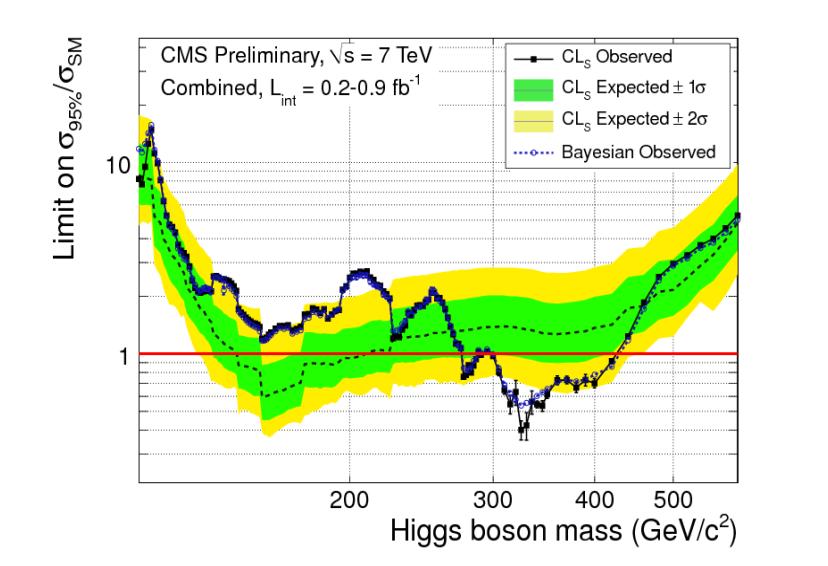A Historic Day? Or Just an Important One?
July 22, 2011. This was no ordinary day.
It has been a sad historic day in Europe, with the murders in Oslo. This tragedy obviously trumps the news from a particle physics conference. Our hearts go out to those suffering in Norway.
But the news story from Grenoble is a big one, and it needs telling before I start to forget it.
I came to this conference fully expecting that there would be a significant number of controversial results from the Tevatron, and virtually none from the LHC except in response to the Tevatron. (Here’s why I expected that.) This was ok by me. I expected to learn a great deal anyway.
Of course I also knew there would be an update from the Tevatron and LHC experiments on the search for the Standard Model Higgs particle. This was also something I expected to be somewhat interesting.
The Standard Model Higgs particle is the simplest possible Higgs particle. The Higgs particle may be more complicated, and/or there may be multiple types of Higgs particles. But right now, at the Tevatron and LHC, the focus is on the following question: is the Higgs particle the one predicted by the Standard Model, and if so, what is its mass?
For years we’ve known that the Standard Model Higgs particle can only have a mass above 115 GeV (the limit comes from a previous collider called LEP II) and below about 800 GeV (the limit comes from a breakdown in the mathematics of the Standard Model.)
The Tevatron experiments CDF and DZero had managed to rule out a chunk of the Higgs mass range around 160 GeV, and updated that result this morning with some improvements, excluding about 155-175. Then came the ATLAS and CMS talks. I thought ATLAS and CMS would do a bit better than the Tevatron experiments. But I was completely wrong.
Starting late this morning and ending by mid-afternoon, I watched in some astonishment as step by step the LHC experiments ruled out most [and probably all-- we'll find out in a month at most when they combine their results] of the Higgs mass region between about 150 GeV and 450 GeV. This represents a giant leap forward, a spectacular end of the Tevatron’s reign, and very big news. The entire intermediate range for the Higgs mass may be gone, eliminated from our collective discussion in one short hour.
But that wasn’t the end of it, by a long shot. When ATLAS showed that they had an excess of events in their search for a Higgs decaying to 2 W particles, of a type not inconsistent with a Standard Model Higgs with mass in the 120-150 GeV range, I sat up a little straighter in my chair. We all waited to find out what CMS would say. And then CMS showed almost the same thing, though with smaller statistical significance. It could have been the reverse, as it has been so many times before; so often when one experiment sees something unusual, its sibling sees something normal, and we go back to our regular business. Not this time.
It was no ordinary day.
But what does it mean? No one knows. We all know of the following reasonable possibilities:
■Perhaps both experiments have had a statistical fluctuation which by chance is of a similar type.
■Perhaps both ATLAS and CMS are relying on theoretical calculations that are in some way inaccurate, or are using them in a way that makes them unreliable, thereby causing an apparent excess of events.
■Perhaps both experiments are not modeling one of their backgrounds correctly, and this is leading to an apparent excess of events.
■Perhaps there really is a Standard Model Higgs particle, or something similar, in the mass range of 120-150 GeV.
How can we tell the difference?
The first option can be addressed with more data; statistical fluctuations will tend to average out in larger data sets. Roughly 4 times the data would be good, and we should have that by fall.
To exclude the second or third is very tricky. The second requires a long discussion involving the experimentalists who did the search for the Higgs decaying to two W particles, and the theorists who are expert in the relevant calculations. I don’t know how long it would take to figure this out; months, perhaps. The third is hard too. Estimating backgrounds can be very tough. This certainly will require many experimental cross-checks. Many of these checks were already done before this data could be presented; many more will be possible with more data.
But it may actually be possible to rule in the fourth possibility, making it unnecessary to rule out the other options.. With more data one should be able to see Higgs particles decaying in ways that are rare but much less subtle to detect. I am thinking of Higgs decays to two Z particles or to two photons. Such decays, when gathered together, can give sharp peaks on a smooth background in data plots. In such cases, precise understanding of the background does not require great theoretical accuracy.
In a few months the experimentalists at ATLAS and CMS should have enough data to be able to straighten this out. I expect by somewhere between December and March we will have a definitive answer as to whether today’s events in Grenoble were truly historic, or merely a major milestone.
A last word of caution. It should still be viewed as unlikely that we have observed the first sign of the Higgs particle. Remember, most hints of new phenomena disappear with more data. But still, while it is true that few hints are followed by discoveries, it is also true that every discovery begins with a hint.
A Historic Day? Or Just an Important One? | Of Particular Significance

 Please Scroll Down to See Forums Below
Please Scroll Down to See Forums Below 


.jpg)






.png)




